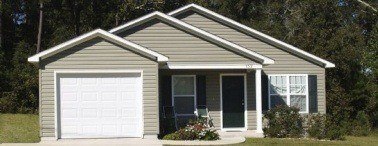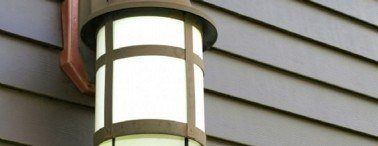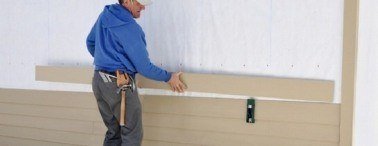
Statistics show that homeowners choose vinyl siding to finish the exterior of their house more often than any other cladding. It graces homes from coast to coast and has been used for decades providing a weather resistant, low maintenance solution. Ideal for new construction and finishing off an addition, vinyl can also be installed when replacing aging cladding or upgrading the energy efficiency of your home.
Why Choose Vinyl Siding Over the Others?
Builders and architects, as well as homeowners and contractors, are always on the prowl for high quality products that deliver a beautiful finish with low maintenance needs, solid performance and measurable value. Vinyl offers all of these things in abundance.
It is undoubtedly beautiful, whether you are building a contemporary residence or restoring a heritage home. The color selection, styles and trim that are available through established manufacturers allows you to create the exact look you desire without any fuss.
No matter where it is used in your home, vinyl is a low maintenance option. It will not fade, warp or weaken, no matter what the weather throws at it, and vinyl cleans up easily with a simple wash down. You can depend on vinyl cladding to last for decades, providing the strength and protection your family demands.
One of the most attractive features of vinyl siding is the value offered. Dollar for dollar, vinyl is your best bet when cladding a new home or addition. It can be used in conjunction with brick, natural stone or stucco to create a unique look that is also affordable. And repairs or replacement on a vinyl clad home are much more reasonable than those requiring the skills of a mason.
What Is Vinyl Siding Made From?
The main component of vinyl siding is PVC (or polyvinyl chloride). This specific type of vinyl gives siding its strength and rigidity, as well as supplying the flexibility and versatility that is required on the homes of today.
PVC consists of chlorine (derived from common salt) and ethylene (derived from natural gas) in nearly equal measure. A majority of the gas used to manufacture the ethylene is domestically produced, making vinyl a responsible economic choice. It's also the safe choice, considering the level of flame resistance that PVC offers.
Is Vinyl Siding Environmentally Friendly?
You may automatically assume that wood siding is a more eco friendly choice than vinyl, but that assumption is far from the truth. Vinyl is a sustainable product that is manufactured responsibly. When installed with insulation, vinyl siding allows for lower energy consumption inside your home, producing fewer CO2 emissions.
The use of vinyl offers the potential to score high on environmental certification systems, such as LEED. It is also handled well on the waste management end, with the effects on the environment always in mind.
Is It Better to Use Insulated Siding?
Insulated vinyl siding has become a popular choice in colder climates where it can lower heating and cooling costs significantly, resulting in more energy efficient and affordable homes.
This product consists of standard vinyl siding that has been laminated together with rigid foam insulation. The most commonly used insulation is polystyrene, a foam that is permanently adhered to the vinyl cladding to produce greater strength and built in protection from harsh temperatures.
Insulated vinyl siding generally offers an R-value of 2.0, which can then be used to boost the R-value created by cavity insulation in your exterior walls. Builders that use insulated vinyl siding have a leg up on the competition by promoting this improved R-value. And homeowners that are looking to upgrade their existing cladding are wise to investigate the cost savings insulated siding lines will provide.
How Does Vinyl Siding Stack Up Against Other Forms of Cladding?
Compare all of the features that vinyl siding offers with those that brick or fiber cement siding deliver. There are advantages and disadvantages to all three, depending on the style of your home, your tastes and your budget. But vinyl is a smart choice on nearly every front, combining an affordable cost with simple repairs, a wide selection of profiles, colors and styles, excellent durability and dependable performance.
There is a reason that vinyl cladding is used on a majority of homes across North America. And the latest research and innovation in the industry are addressing any challenges that have arisen in the past. Brick cladding is perhaps the most traditional method of exterior siding and continues to offer strength, beauty and durability. It is, however, expensive to install and repair.
Fiber cement is one of the most recent introductions in the industry and offers a wide variety of advantages. It has the charm and beauty of wood siding, with the added strength of cement. It is also complicated to install and repair, as well as being less affordable than vinyl. Your tastes may lean towards one of the two pricier options and both are reliable and appealing, but vinyl is perhaps the only cladding choice that combines all of the factors in one product.
Do You Need to Hire a Certified Installer for Vinyl Siding?
Although it is flexible and straightforward to install, it is wise for builders, homeowners and general contractors to hire a certified installer when finishing a home's exterior in vinyl. These professionals will have the training, equipment and safety skills necessary to get the job done properly and quickly.
Vinyl siding behaves in a certain way when exposed to the elements. Your installer needs to fasten the siding together properly to allow for this normal expansion and contraction. Each certified installer is required to study and train on the latest methods of installation, taking into account any innovations and advances that the industry has taken. They are also knowledgeable about how to incorporate details and finishing touches that will allow your home to stand out from the rest. Certified contractors are familiar with the established brands and know how to create a proper fit around doors and windows, blocking water from infiltrating the framing and insulation behind your siding. It is specialized work that requires thorough training in order to achieve the best possible results.
That being said, vinyl siding is often carried as a DIY product. Repairs, replacement and additions can be tackled by the average handyman or handywoman who has been carefully instructed on installation techniques.
Vinyl siding is a popular choice for many homes across North America, and for good reason. A solid, dependable and low maintenance option that presents a beautiful finish on your home, vinyl cladding is also affordable and environmentally friendly. Consider the benefits that this
Posted by: TrustedPros





